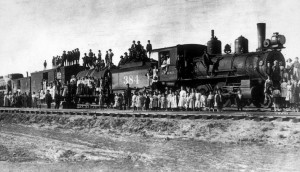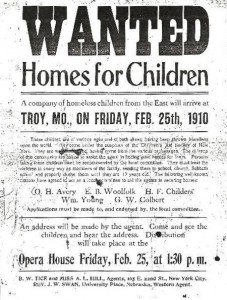 I received a phone call the other day from my parents as they were driving through Kansas on a road trip. They wanted to tell me about a curious roadside advertisement they had seen that they thought would interest me: the National Orphan Train Complex in Concordia, Kansas. I had never heard of this museum, let alone its subject, so I decided to do some sleuthing. What I discovered was an intriguing, controversial, and apparently slightly obscure facet of American history.
I received a phone call the other day from my parents as they were driving through Kansas on a road trip. They wanted to tell me about a curious roadside advertisement they had seen that they thought would interest me: the National Orphan Train Complex in Concordia, Kansas. I had never heard of this museum, let alone its subject, so I decided to do some sleuthing. What I discovered was an intriguing, controversial, and apparently slightly obscure facet of American history.
According to the museum’s website, the Orphan Train Movement transported around 250,000 needy, neglected, and orphaned children from New York to other regions of the United States and Canada from 1854 to 1929. Inspired by the roughly 30,000 orphaned children calling the streets of New York home, Charles Loring Brace founded the Children’s Aid Society, whose orphan train movement has been largely lauded as the beginning of the foster care system in America.[1] A quick look in the 1900 U.S. Census at the New York Foundling Hospital, one of the institutions from which many of these children were taken, adds a stark reality to this trend of poverty and abandonment. The hospital, located in Brooklyn, spans 2½ pages of the census, and many of the children under its care cannot even list their parents’ place of birth.[2]
 New York Foundling Hospital, 1900
New York Foundling Hospital, 1900
Advertisements were sent to cities along the trains’ routes and screening committees were established to place children with new families which were required to sign contracts promising fair treatment and education for the children.[3] Trains then arrived with thirty or forty children accompanied by a few society representatives. At each stop, the children were lined up on stages and inspected, a process that betrayed what was often the primary motivation of adoptive families: labor.[4]
One of the most readily available examples of the orphan train advertisements is the one included here, alerting residents of Troy, Missouri, of the locomotive’s arrival on 25 February 1910 at 1:30 in the afternoon. While many of the children would have been dispersed from the immediate area after adoption, we can see that in the 1910 U.S. Census for Troy there were two adjacent families both counting a New York-born orphan among their household members.
 Kuhne and Howell households, Ward 2, Troy, 1910
Kuhne and Howell households, Ward 2, Troy, 1910
Philip Kuhne, a merchant, and his wife, Lenora, took in four-year-old John M. K. Monahan. They only had one child of their own, five-year-old Camille, and may have been anticipating a need for the help of a young boy at the family shop or simply felt compelled to adopt.[5] The orphan train experience may have worked in John’s favor, as he seems to have been eventually integrated into the family, taking their last name, and naming his second son Philip.[6]
 Household of Philip and John M. Kuhne, Troy, 1940
Household of Philip and John M. Kuhne, Troy, 1940
Seven-year-old Theodore Smith was taken in by farmer Will A. Howell, his wife Daisy, and Will’s mother Hetty. Unlike John Monahan, Theodore appeared not to have known much about his parents, as their places of birth were listed as “unknown.”[7] Theodore also does not seem to have been as fortunate as John. He was not living with the Howells ten years later in 1920, but rather was found the next town over in Bedford, Missouri, with sixty-year-old Annie Heady.[8] After that, he disappears from the record.
![]() Household of Annie Heady, Bedford, 1920
Household of Annie Heady, Bedford, 1920
The history of the Orphan Train Movement was conflicted, tied as it was to trends in child labor and the inherent tragedy of being orphaned in the first place. Some of these children undoubtedly found better lives and new families like John Monahan Kuhne. Others, like Theodore Smith, were less fortunate and likely suffered abuse, prejudice, and poor working conditions. Many genealogy enthusiasts are drawn to the pursuit through a desire to define themselves in relation to others that have come before, but that process becomes complicated when an individual is severed from his or her family history like these riders of the orphan trains.
Still, many of these children grew to raise families and start lineages of their own. If you or anyone you know has come across an orphan train ancestor, there are ways to access to their records, although they are closely monitored due to the sensitivity of adoptions. Information about these records and other institutions associated with the movement can be found here.
Notes
[1] “History,” National Orphan Train Complex, http://orphantraindepot.org/history/.
[2] Foundling and Charity Hospital, Year: 1900; Census Place: Brooklyn Ward 29, Kings, New York; Roll: 1068; Page: 13A; Enumeration District:0548; FHL microfilm: 1241068. Ancestry.com. 1900 United States Federal Census [database on-line]. Provo, Utah: Ancestry.com Operations Inc., 2004.
[3] “The Children’s Aid Society,” National Orphan Train Complex, http://orphantraindepot.org/history/the-childrens-aid-society/.
[4] D. Bruce Ayler, “The Orphan Train Experience,” National Orphan Train Complex, http://orphantraindepot.org/history/the-orphan-train-experience/.
[5] Philip Kuhne, Year: 1910; Census Place: Troy Ward 2, Lincoln, Missouri; Roll: T624_794; Page: 5A; Enumeration District: 0082; FHL microfilm: 1374807. Ancestry.com. 1910 United States Federal Census [database on-line]. Provo: Ancestry.com Operations Inc., 2006.
[6] Philip Kuhne, Year: 1940; Census Place: Troy, Lincoln, Missouri; Roll: T627_2124; Page: 8B; Enumeration District: 57-1. Ancestry.com. 1940 United States Federal Census [database on-line]. Provo: Ancestry.com Operations, Inc., 2012.
[7] Will A. Howell, Year: 1910; Census Place: Troy Ward 2, Lincoln, Missouri; Roll: T624_794; Page: 5A; Enumeration District: 0082; FHL microfilm: 1374807. Ancestry.com. 1910 United States Federal Census [database on-line]. Provo: Ancestry.com Operations Inc., 2006.
[8] Annie Heady, Year: 1920; Census Place: Bedford, Lincoln, Missouri; Roll: T625_933; Page: 1B; Enumeration District: 95; Image: 29. Ancestry.com. 1920 United States Federal Census [database on-line]. Provo: Ancestry.com Operations Inc., 2010.
Share this:
About Anna Todd
Anna holds a Master’s degree in history from the University of Connecticut where she specialized in gender and law in colonial New England. She completed her Bachelor’s degree in history with a minor in English at the University of Southern Mississippi. Prior to joining the research services staff at NEHGS she worked as a page at the Thomas J. Dodd Research Center at the University of Connecticut and volunteered with the McCain Library and Archives at the University of Southern Mississippi, the Mississippi Department of Archives and History, the Eudora Welty House, and the National History Day Organization. Her interests include colonial America, New England, Pennsylvania, and the South, and she enjoys infusing family histories with interesting information found in court records, wills, city directories, and other supplementary sources.View all posts by Anna Todd →
